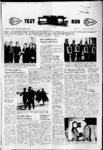| OCR Text |
Show Dugway Proving Ground, Friday, Jan. 27, 1967 Field Printing Plant Ever wonder where the Daily Bulletin is printed? How alxmt DPG Regulations, or the myriads of testing programs used in Ditto Area - or those thick manuals sitting on the comer of vour desk? Well, if your answer is the Dugway Field Printing plant, you are correct. Located in building No. 5466, adjacent to the commercial traffic office, this rather compact office produces over 500,000 units 'each month. A unit", in the printing business, is one 8x10 sheet of paper printed on one side. For a small plant like ours, this is an impressive average. JOHN W. SCIIRIER is the foreman of the plant. He hails from St. Louis, Missouri. Like so many ol' timers on Dugway, he arrived with the intention of staying a couple of years - but that was eight years ago. fie is the father of four girls and one boy (a parakeet). Mrs. Ernest Anderson, the film stripper and assembler, has worked at field printing for almost 13 years. She is the only remaining member of the crew which worked in the old field printing plant in Ditto Area. Richard N. Bate has worked for the plant for approximately six years. Mr. Schrier says that he is one of the best off-spress to the group, John W. operators in the business. A Castagno, is also an off-spress operator and has been with field . et ncw-com- et MR. JOHN CASTACNO, a pica operator, checks the alignment of the proper reproduction of the Daily Bulletin. off-s- pica to insure printing for about three months. ABOUT THE TIME Dugway was established, the printing plan was an integral part of the Editorial Branch of Test Design and Analysis, located in Ditto Area. In October, 1953, the plant was authorized as a class A printing plant. Reorganization of the various printing facilities on the installation placed all the printing organizations under one directorate in October of 1957. In 1958, the whole works was moved to English Village and bined with the publications branch at its present location. All commercial printing today is produced by one of three off-smajor processes: letter-pres- s, lithography and gravure. Our plaint employs mainly the off-s- et lithography method. The off-slithography prpeess allows greater latitude in printing. Because lithography is planographic, there is no ' lon bite into the from a paper; and, since the image is off-srubber blanket onto the paper, there is enough give in the blanket to compensate for the most textural surfaces. FIELD PRINTING utilizes two multigraph multilith offset duplicators, class 1250. These presses employ the multilith off-sduplicating process, which is based on the principle that a grease substance and water will not mix. An image placed on the duplicating master by means of a grease or ink attractive substance will accept ink from the ink rollers of the duplicator but will reject moisture from the repelex, or moisture roller. Conversely, ink will not adhere to th clear, area of the master because of the moisture. Perhaps the most fascinating piece of equipment at field Photo-DireCamera printing is the Addressograph-Multigrap- h Processor 705. This machine is a completely automated unit demasters in minutes, by means of the igned to process off-slatest photographic techniques. r, Once the is turned on and copy is placed on the copyboard, a touch erf the controls will produce a finished, duplicator-read- y master. These masters can then be placed on the off-spresses to produce thousands of perfect copies. 1 et et et non-ima- ct et camera-processo- et MR. JOHN SCHRIER, printing plant foreman, operates the Addressograph-Multigrap- h THIS MULTIGRAPH AUTOMATIC EXPOSURE CABINET is used to expose light sensitive Multilith masters. The masters are then developed and placed on the printing presses to e hundreds of copies. Photo-Dire- Camera Processor. pro-duc- . THIS IS AN electrically controlled hole punch. It is capable of producing different sized holes, from one-hal-f to one-eight- h inch. MR. RICHARD BATE applies pressure to the rollers of the printing press to assure the even Row of ink upon the Multilith master. I ' ' I A |












